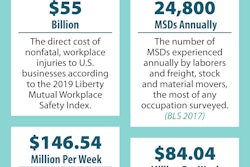
As the skills gap worsens in the manufacturing and supply chain industries, companies are getting serious about how they are attracting and training younger workers as well as upskilling and engaging their existing staff. Estimates from Deloitte’s new study reports nearly 4.6 million manufacturing and supply chain jobs will likely need to be filled in the next decade, and due to the lack of skilled workers, over two million of those jobs are predicted to stay open.
Recently, Amazon made headlines with its announcement of a $700 million investment to retrain its workforce. The company recognizes its workers are going to have to gain new skills to fill the open positions caused by increased advanced automation and new technology in the supply chain. Amazon’s “Upskilling 2025” pledges to spend approximately $7,000 per worker in order to tackle the skills gap and help prepare the supply chain industry for more changes to come. The move will also make its existing workforce and operations more competitive.
Supply chain companies looking to stay competitive will have to train either new or existing workers using a good technical program that is affordable and effective. And due to the sheer numbers of workers needing skill development, companies must find methods to scale their training programs in order to accommodate more onboarding. Using tools such as simulation and the concept of serious games in training programs is one way organizations can do this.
Read Next: Five Tips for Recruiting Gen Z to the Supply Chain Industry
Using serious games in training
Who doesn’t love games? Games are inherently designed to be fun, interactive and to keep participants engaged over a period of time to reach specific goals. Sounds a lot like the elements of a good training and employee engagement program, which is why this concept is being incorporated into new workforce development strategies.
Serious games are games that aren’t meant merely to entertain, although they might do that as well, but their purpose is to teach a skill or allow one to practice it. The concept might seem new, but it has gained a lot of attention from those in the education, defense, aeronautics and health care industries. In fact, according to the industry analyst firm Metaari, revenue from programs based on hands on, experiential learning known as serious games hit $3.5 billion in 2018 and is predicted to grow to more than $17 billion by 2023.
While not all serious games involve simulation, they can be combined to result in an effective teaching medium. The most common conception of simulation and training is via a simulator, such as those used to train novice airplane pilots. However, virtual reality (VR) and augmented reality (AR) applications are increasingly being used in a number of professions, such as health care workers and training forklift operators.
The growing need for simulation training
To start building the next-gen workforce for the supply chain, companies should identify workers’ missing skills that could pose production risks. Some of these risks on the plant floor are unplanned downtime and decreased reliability of equipment.
Apprenticeships is one area that has gained some popularity when discussing manufacturing and supply chain training programs, however, there are drawbacks to this approach. First is cost; McKinsey has estimated putting one million workers in apprentice programs could cost $40 billion annually. Secondly, apprenticeships are difficult to scale up because they are generally limited to one-on-one relationships.
However, computer-based simulation programs can offer scalability and affordability advantages to supply chain companies. Additionally, this method of training is extremely flexible and can be accessed from anywhere, anytime, enabling a more accommodating skills delivery method.
Plus, assessing what people already know and what they have learned from their training is another key area computer-based simulation training programs can provide. Allowing managers and directors to quickly understand where their employees are at in their skills development journey can enable organizations to more efficiently and effectively prepare the future supply chain workforce.
The learning pyramid for supply chain training
While Amazon’s “Upskilling 2025” plan is ambitious and certainly a major capital expense, a company’s training program must be effective, no matter the amount of the investment. To do this, having an understanding of knowledge transfer is necessary, and one method used to explain this is the learning pyramid. This concept breaks up different learning activities into categories, such as listening to lectures, reading, practicing, etc. Studies have shown that those using passive ways of learning, such as listening in a classroom or reading a textbook, will retain less of the material than those using active methods, such as practicing a task or teaching others how to do it.
For those responsible for teaching in plant environments, one common method to train new personnel is the “buddy system.” This is when a seasoned professional takes a rookie onto the plant floor and shows him or her how to troubleshoot problems and fix equipment. In terms of retention rates, it is more effective than a classroom setting, but bad habits can be passed down to new employees. Plus, this training method can’t easily be scaled up since only a limited amount of people can be trained at a time.
The best retention rates are attained by having learners practice a skill. In plant environments, however, this is not typically a best practice due to the potential risk of injuries and damage caused by having untrained workers practice on live equipment.
However, using simulation training, real conditions are artificially represented as an instructional strategy for students to learn and practice problem-solving skills in a realistic environment, but without the risk of danger. For this reason, simulation training is particularly useful in applications, such as supply chain operations, where trainees could cause harm to others or themselves, or damage expensive equipment.
Read Next: How Much Should a Supply Chain Manager Make?
The future of supply chain work
While there are many uncertainties in how increased automation will change the supply chain in the next decade, what is clear is that the current workforce will have to attain more and different skills. With many companies in the industry already having trouble finding workers with the right knowhow, this problem is likely to worsen if no clear retraining program is put into place.
This shortage of skilled workers is exacerbated by the aging manufacturing workforce retiring in droves. For future generations, retooling traditional education systems will be needed in part to refocus efforts on teaching more math and digital skills. However, for today’s supply chain worker, the private sector will likely have to play a big role in the retraining efforts.
Supply chain companies will have to follow Amazon’s lead to ensure they have a workforce that will take their businesses into the future. But investing in the right training programs that are cost-effective, offer scalability and can help attract and retain younger workers will be crucial.



















